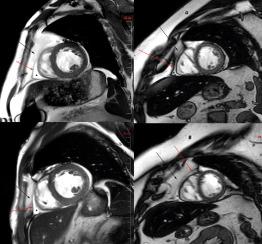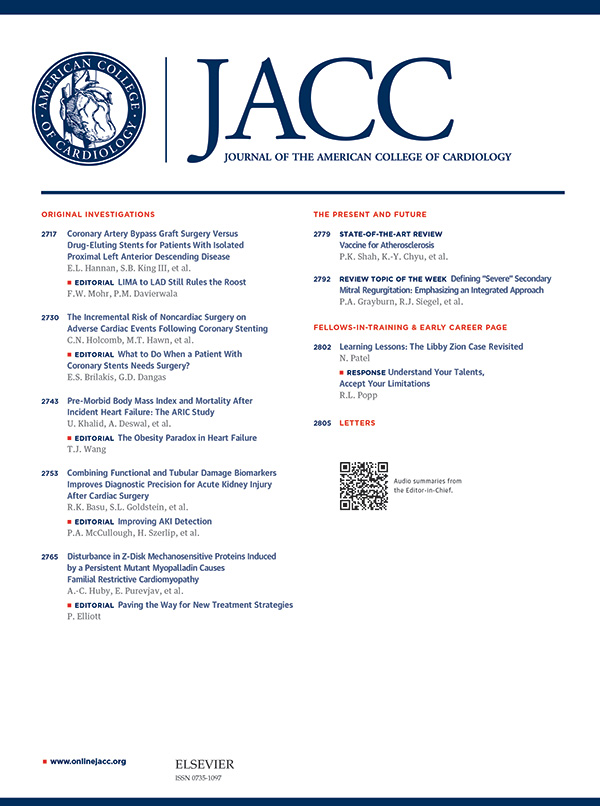Tirzepatide Reduces LV Mass and Paracardiac Adipose Tissue in Obesity-Related Heart Failure: SUMMIT CMR Substudy
IF 21.7
1区 医学
Q1 CARDIAC & CARDIOVASCULAR SYSTEMS
引用次数: 0
Abstract
Background
Obesity is a known risk factor for heart failure with preserved ejection fraction (HFpEF) and is considered a distinct phenotype with more concentric remodeling. Epicardial adipose tissue (EAT) is also increased in obesity-related HFpEF and is associated with adverse events.Objectives
The cardiac magnetic resonance (CMR) substudy of the SUMMIT trial aimed to examine the effects of tirzepatide on cardiac structure and function with the underlying hypothesis that it would reduce left ventricular (LV) mass and EAT in obesity-related HFpEF.Methods
A total of 175 patients with obesity-related HFpEF from the parent study of tirzepatide (2.5 mg subcutaneously weekly, increasing to a maximum of 15 mg weekly) or matching placebo underwent CMR at baseline, which consisted of multiplanar cine imaging. A total of 106 patients completed the CMR and had adequate image quality for analysis of LV and left atrial structure and function and paracardiac (epicardial plus pericardial) adipose tissue at both baseline and 52 weeks. The prespecified primary endpoint of this substudy was between-group changes in LV mass.Results
LV mass decreased by 11 g (95% CI: −19 to −4 g) in the treated group (n = 50) when corrected for placebo (n = 56) (P = 0.004). Paracardiac adipose tissue decreased in the treated group by 45 mL (95% CI: −69 to −22 mL) when corrected for placebo (P < 0.001). The change in LV mass in the treated group correlated with changes in body weight (P < 0.02) and tended to correlate with changes in waist circumference and blood pressure (P = 0.06 for both). The LV mass change also correlated with changes in LV end-diastolic volume and left atrial end-diastolic and end-systolic volumes (P < 0.03 for all).Conclusions
The CMR substudy of the SUMMIT trial demonstrated that tirzepatide therapy in obesity-related HFpEF led to reduced LV mass and paracardiac adipose tissue as compared with placebo, and the change in LV mass paralleled weight loss. These physiologic changes may contribute to the reduction in heart failure events seen in the main SUMMIT trial. (A Study of Tirzepatide [LY3298176] in Participants With Heart Failure With Preserved Ejection Fraction [HFpEF] and Obesity: The SUMMIT Trial; NCT04847557)

替扎帕肽可减少肥胖相关性心力衰竭患者的左心室质量和心旁脂肪组织:SUMMIT CMR 子研究
背景肥胖是已知的射血分数保留型心力衰竭(HFpEF)的危险因素,被认为是一种具有更多同心重塑的独特表型。SUMMIT试验的心脏磁共振(CMR)子研究旨在检查替扎帕肽对心脏结构和功能的影响,其基本假设是替扎帕肽可减少肥胖相关性HFpEF的左心室(LV)质量和EAT。方法在基线时,共有 175 名肥胖相关 HFpEF 患者接受了包括多平面 cine 成像在内的 CMR 检查,这些患者来自替扎帕肽(每周皮下注射 2.5 毫克,最多每周注射 15 毫克)或匹配安慰剂的母体研究。共有 106 名患者完成了 CMR,并在基线和 52 周时获得了足够的图像质量,用于分析左心室和左心房的结构和功能以及心旁(心外膜加心包)脂肪组织。结果经安慰剂组(n = 56)校正后,治疗组(n = 50)的左心室质量减少了 11 克(95% CI:-19 至 -4 克)(P = 0.004)。经安慰剂校正后,治疗组的心旁脂肪组织减少了 45 mL(95% CI:-69 至 -22 mL)(P <0.001)。治疗组左心室质量的变化与体重的变化相关(P <0.02),并与腰围和血压的变化呈相关趋势(P = 0.06)。结论SUMMIT试验的CMR子研究表明,与安慰剂相比,替扎帕肽治疗肥胖相关的HFpEF可导致左心室质量和心旁脂肪组织减少,左心室质量的变化与体重下降同步。这些生理变化可能有助于减少 SUMMIT 主要试验中出现的心衰事件。(射血分数保留型心力衰竭[HFpEF]合并肥胖患者的替哌肽[LY3298176]研究:SUMMIT试验;NCT04847557)
本文章由计算机程序翻译,如有差异,请以英文原文为准。
求助全文
约1分钟内获得全文
求助全文
来源期刊
CiteScore
42.70
自引率
3.30%
发文量
5097
审稿时长
2-4 weeks
期刊介绍:
The Journal of the American College of Cardiology (JACC) publishes peer-reviewed articles highlighting all aspects of cardiovascular disease, including original clinical studies, experimental investigations with clear clinical relevance, state-of-the-art papers and viewpoints.
Content Profile:
-Original Investigations
-JACC State-of-the-Art Reviews
-JACC Review Topics of the Week
-Guidelines & Clinical Documents
-JACC Guideline Comparisons
-JACC Scientific Expert Panels
-Cardiovascular Medicine & Society
-Editorial Comments (accompanying every Original Investigation)
-Research Letters
-Fellows-in-Training/Early Career Professional Pages
-Editor’s Pages from the Editor-in-Chief or other invited thought leaders

 求助内容:
求助内容: 应助结果提醒方式:
应助结果提醒方式:


